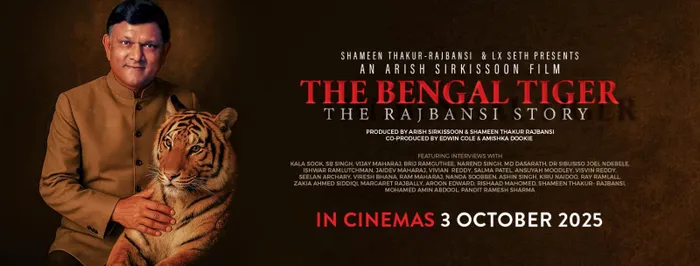Remembering the Milk Carnival and the legacy of Amichand Rajbansi
Social cohesion in the Indian community during apartheid

The Bengal Tiger -The Rajbansi Story, a documentary film, will release in cinemas next month
Image: Supplied
I WAS fortunate to have attended the premiere of The Bengal Tiger – The Rajbansi Story. Watching the film unfold, I was reminded of just how complex, remarkable, and often misunderstood Amichand Rajbansi was as a leader.
For those of us who grew up hearing stories about the Milk Carnival he championed, the memories still bring broad smiles to the faces of elders who narrate them. These stories are not just nostalgic recollections of song and dance; they are powerful reminders of the importance of social cohesion within the indentured Indian community of Durban during apartheid.
The Indian community in South Africa has long occupied a precarious and in-between position, one that fostered both uncertainty and remarkable endurance. Out of this space of ambiguity emerged determination, as leaders, cultural organisers, and everyday families invested effort in binding their people together. For them, social cohesion was essential, not optional: without it, the community risked splintering, fading into invisibility, or being erased altogether.
It was the rhythms of cultural life expressed through temples and mosques, neighbourhood schools, music halls, and vibrant carnivals that served as connective tissue, sustaining identity, offering inspiration, and ensuring that Indianness remained visible in the broader South African mosaic.
Against this backdrop, the Milk Carnival emerged as more than just an entertainment event. Organised in Durban in the 1970s and 1980s, often under the patronage of Rajbansi and the Durban Milk Publicity Council, the carnival attracted thousands. Reports recall audiences of 50 000 to 80 000 people gathered at the Unit 3B football ground in Chatsworth to watch artists perform.
The carnival featured everything from live music and dance to tug-of-war contests and wrestling. It was an explosion of community life under conditions designed to suppress it. For the Indian community, the Milk Carnival carried layered significance that went far beyond entertainment. It became a stage for cultural preservation, showcasing Indian music, dance, and performance at a time when minority identities were under threat of erasure.
The familiar sounds of Hindi songs, the grace of classical dance, and the sight of sari-clad performers affirmed a collective pride in heritage. At the same time, the Carnival was a powerful force for social cohesion, drawing together families from across Durban regardless of caste, class, or religion. In that space, divisions blurred, and a shared identity was joyfully celebrated. Just as importantly, it served as a platform for talent, launching careers for artists such as Shashika Mooruth, who recalls performing before audiences of tens of thousands as a young child artist.
Many singers, dancers, and performers might never have been seen or heard were it not for the carnival, which created rare opportunities under the restrictive conditions of apartheid. In its entirety, the carnival stood as a living symbol of how a marginalised community could generate joy, resilience, and pride, affirming its place in a society determined to render it invisible.
Rajbansi is remembered as a polarising figure in South African politics. His role in the apartheid-era House of Delegates remains contested. Critics often accused him of collaboration, while supporters saw him as a pragmatic operator who used limited political space to secure resources for his community. But to reduce Rajbansi’s legacy only to parliamentary manoeuvres would be unfair. Through initiatives like the Milk Carnival, he demonstrated an instinctive understanding of the importance of social cohesion and cultural visibility.
He recognised that communities needed more than political rhetoric; they needed spaces of belonging, joy, and unity. The carnival, therefore, was not just about milk publicity or entertainment; it was about stitching together the social fabric of a people under siege. Watching The Bengal Tiger reminded me that Rajbansi’s leadership must be read in this fuller context. He was deeply committed to ensuring that his community had platforms for identity, cohesion, and dignity.
The Milk Carnival also sheds light on how Indian identity itself was constructed during apartheid. Unlike Indian diasporas in the UK or USA, South African Indians were cut off from India for much of the 20th century due to apartheid and global sanctions. Cultural traditions were preserved not through continuous exchange but through reinvention on South African soil. Events like the Milk Carnival played a key role in this reinvention. They allowed Indian South Africans to celebrate heritage while simultaneously embedding it in a uniquely South African experience.
Tug-of-war matches stood alongside Bollywood songs; sari queens shared the stage with local comedians. Identity was not imported wholesale from India; it was stitched together in Durban, Ladysmith, and Pietermaritzburg, shaped by apartheid and by the creativity of the diaspora.
When I hear elders speak about the Milk Carnival, I am struck by the warmth with which they recall it. Eyes light up as they describe the music, the dancing, the food stalls, the crowds. For them, the carnival was more than diversion; it was memory-making, resilience in action. These stories are important because they remind us that history is not only about oppression and struggle; it is also about joy, survival, and creativity.
In apartheid South Africa, joy was itself a form of resistance. To gather so many people in one place to celebrate identity was to declare: “We are still here, we are visible, and we are proud.”
The Milk Carnival, and events like it, underscore a lesson still relevant today: social cohesion is essential for survival and progress. For the indentured Indian community, cohesion provided resilience against exclusion. It gave children role models, artists a platform, and families a sense of belonging. It transformed isolation into solidarity. In post-apartheid South Africa, where communities still grapple with inequality and division, the principle holds. Cohesion is not automatic; it must be cultivated through cultural expression, dialogue, and shared spaces.
Rajbansi, through initiatives like the carnival, understood this well. His legacy lies in this commitment to building cohesion in a fractured society. Today, the Indian community in Durban faces new challenges: generational shifts, emigration, and fears of cultural dilution. Many young people no longer speak their grandparents’ languages or wear traditional clothing.
The sari queen pageants and cultural shows that once dominated community life are often dismissed as outdated. But perhaps the lesson of the Milk Carnival is not that we must cling to old formats, but that we must constantly reimagine ways of creating cohesion. Just as the carnival combined dance with wrestling, milk promotions with cultural pride, so too must today’s leaders blend tradition with innovation.
Youth festivals, digital platforms, and entrepreneurship incubators can serve the same purpose: keeping communities connected, visible, and proud.
Watching The Bengal Tiger reminded me that leaders like Rajbansi understood something fundamental: culture and cohesion are as important as politics and policy. The Milk Carnival was more than a marketing stunt or a nostalgic memory; it was a bold statement of resilience and identity. As we move forward in post-apartheid South Africa, let us not forget the lesson: unity and identity are forged not only in parliaments or protests but also in carnivals, songs, and shared memories.

Dr Aradhana Ramnund-Mansingh
Image: File
Dr Aradhana Ramnund-Mansingh is the manager, School of Business, Mancosa; empowerment coach for women and former HR executive.
** The views expressed do not necessarily reflect the views of IOL or Independent Media.